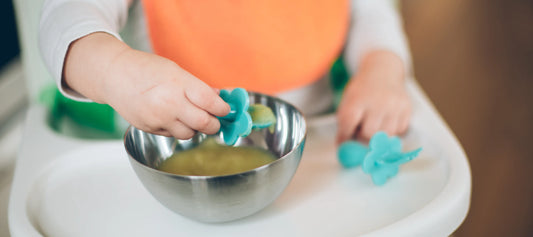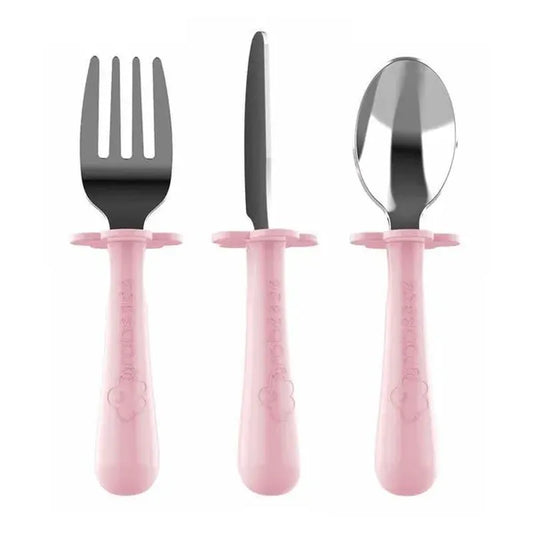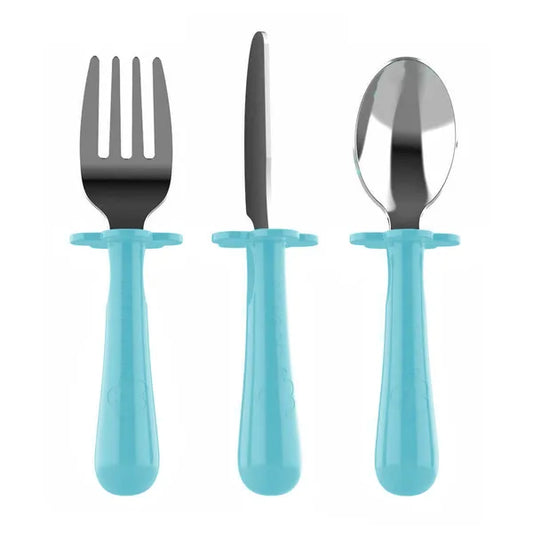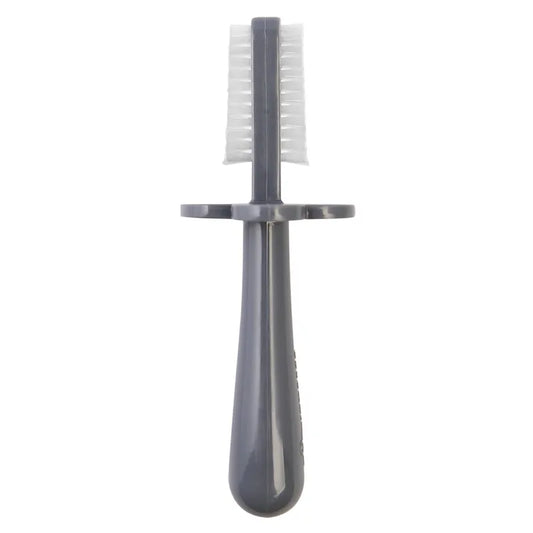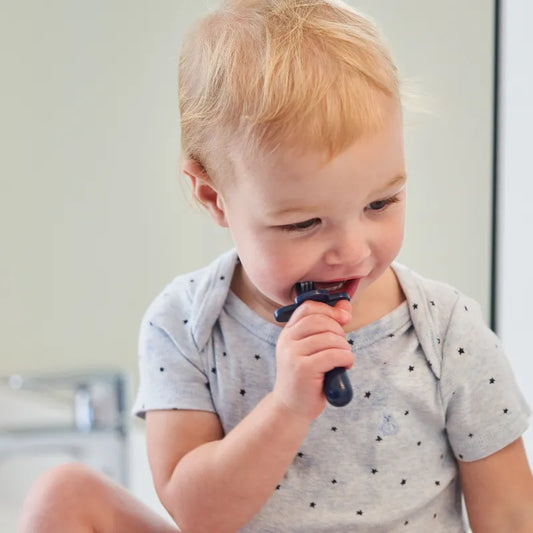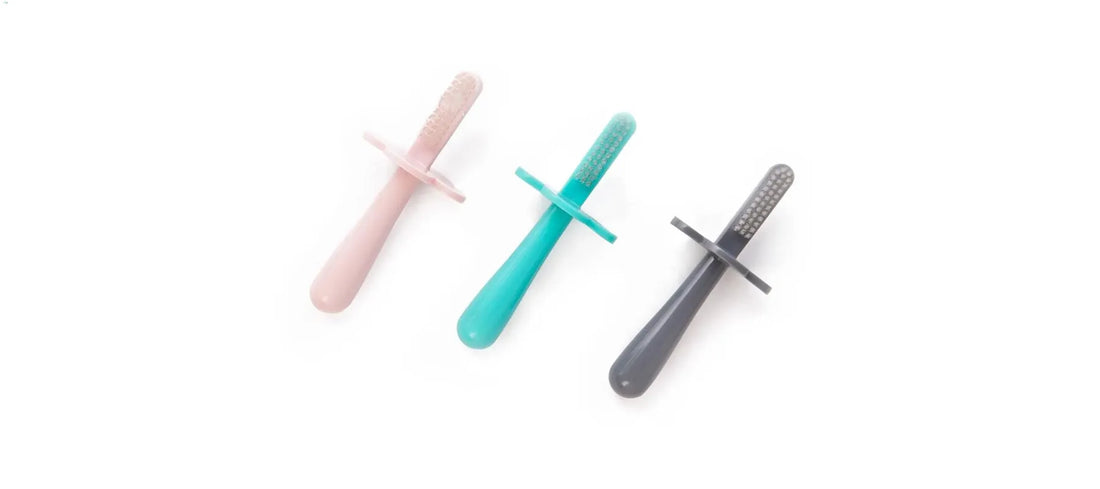
Toddler Tooth Care
Share
Have you started solids with your Baby? Have you also started a dental routine? If not, you're in the right place. Caroline Fenton will guide you through the ins and outs of toddler tooth care.
The Lowdown on Toddler Tooth care
That first glimmer of white usually appears between the ages of 6 and 10 months. Although some bubs are even born with a tooth or two, and others won’t crack their first until after their first birthday. Between the ages of 6 months and 3 years, our bubbas will gain all 20 of their teeth!! Eeeeeep, yep 20! It’s a good job we can’t remember this stage when we grow up, as teething is SO not fun (for mum or baby). The sore gums, endless drool, irritability, upset tummies, rashy chins and bums, restlessness… it’s not nice to see your little one so uncomfortable.
Teeth actually begin to form in the second trimester of pregnancy. At birth, your baby has 20 primary teeth, some of which are fully developed in the jaw. These teeth can appear out of the gums in any order they like, but often you will see the two middle bottom teeth (central incisors) pop up first. Last to come in are the molars at the back. This set of baby teeth are then replaced with 32 adult teeth from around the age of 6.

Infographic credit: Mamanatural.com
Should I be cleaning gums before any teeth have even come through?
Yes! You can use a clean damp cloth to just wipe over the gums to clear away any harmful bacteria. If they are teething, they will love the pressure on the gums. Plus, it gets baby use to the idea of teeth cleaning and you sticking something in their mouth… #winning
How often should I brush their teeth?
Same as with adults, these baby teeth need cleaning twice a day – in the morning after breakfast and before bed, after dinner.
What should I do to clean them?
Brush the inside and outside of their teeth, as well as their tongue, if they will let you! No need to worry about flossing at this age (only when teeth start to touch, and the brush can’t get in between them).
What should I use?
An age appropriate brush is perfect. The grabease double-sided toothbrush is sutiable from 6 months and it comes with a stage 1 silicone finger-brush which is suitable from 4 months. Just using a brush with water is fine until they are 18 months old. From then on, you can use a rice size amount of low-fluoride toothpaste (increasing to pea-sized amount at around 3 years old
Manual or Electric?
This is up to personal preference after the age of 3… Electric brushes can be pretty fun!. Plus, if mummy and daddy use one then they will probably want to have a go at electric too! They can also give a better clean compared to manual brushes… but really, it’s up to you (or let’s be honest, it’s up to your kid!)
Fluoride or no fluoride?
Fluoride is a mineral that helps teeth grow strong. It also prevents tooth decay by strengthening tooth enamel and making it more resistant to acids and harmful bacteria.. It is best in small quantities i.e. in the water we drink, foods, and low-fluoride toothpaste. Most tap water in Australia has very low amounts of added fluoride (your local authority will be able to tell you the levels). If children take in too much fluoride, it can cause fluorosis, which is a build-up of fluoride, resulting in white marks on the teeth. Best to keep the levels down until they are old enough to rinse and spit.
For under 18 months toothpaste is not actually needed, unless a dentist advises otherwise. From 18 months, a low fluoride toothpaste is recommended. You can also find fluoride free toothpastes if you are concerned with the levels. These are also available in fruity flavours if your little one isn’t a fan of the minty options!
Who should be doing the brushing?
Most likely they will want to ‘help’ i.e. do it themselves!! You can give them a toothbrush to hold while you brush their teeth. They can likely have a go themselves but always be sure to ‘check’ for them 😉 When they are around 8 years old you can probably trust they will do a good enough job on their own, but below that age you will want to supervise and ensure they are not swallowing toothpaste and doing a thorough job.
How do I fit it into our busy routines?
Kids love a routine, they know what’s coming next and it helps them feel safe and secure. As much as it may feel like a chore (and it’s not always easy, cleaning little teeth!), stick to the plan and be sure to get it done each morning and night. That way, there will be much less wiggle room (quite literally!)
When do they need to see the dentist?
It’s a good habit to get into when they are young, so it becomes part of their normal routine, and not something they dread! Take them along to the dentist when they are around 1, or 6 months after their first tooth appears. From them on, regular check ups will help keep their teeth in healthy condition and the dentist can offer advice with any issues they may be having.
How can I make it fun?
Depending on what your kid likes, there are a few ways to get the job done:
– For the young ones, a toothbrush for them to hold is a must have
– Also them seeing themselves in the mirror can be a good distraction
– You can set a timer so they know how long you will be brushing for (also a good visual distraction). This can be a traditional egg timer or simply from an app on your phone.
– A song is always a good way to get the brushing happening and also some distraction too. Have a selection they can pick from, sing, or play it and they know that the teeth brushing happens for the duration of the song
– Pretending to ‘roar’ like a dinosaur, toot like a train, or get them to say their alphabet… anything they like that will get them making the right shapes to get in all the nooks and crannies!
– You can always bring up a you tube video or short clip of a favourite show, song, or even kids brushing their teeth as a bit of entertainment
What about foods?
As we know, sugary foods can cause tooth decay and erode enamel and cause cavities. The main culprits are juices, lollies, dried fruit, etc. These foods are best avoided in babies and toddlers under 2 years of age. If you decide to serve these types of food before 2, it’s best to give bubs a big drink of water to rinse the sugar from their teeth. This helps the sugar not sit on the teeth for too long.
What about bedtime bottles?
As comforting as a bedtime bottle is, these liquids then just feed on bacteria in the mouth and cause tooth decay. This can lead to a condition called ‘bottle mouth’ where the front teeth are discoloured, pitted and cavities may develop. This is true for milk, formula or juice, and even sweetened medicines. So best avoided as soon as you can break the habit.
So there you have it, our toothcare lowdown! I hope this helps you and your littles on your teething journey.
Make brushing easier with the grabease double-sided toothbrush!
About the Author

|
Caroline is a Perth mum to two premmie babes now 1 and 4 years old. With tricky starts to life for both (and to motherhood!), Caroline has researched, tried and tested many natural, organic products to find those that are good for her babes and the environment too.
|


